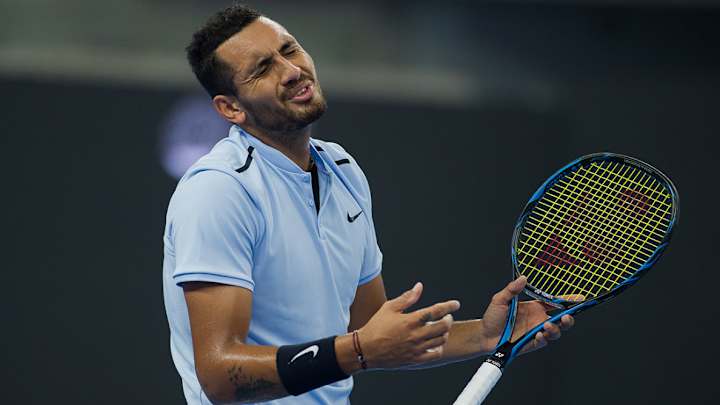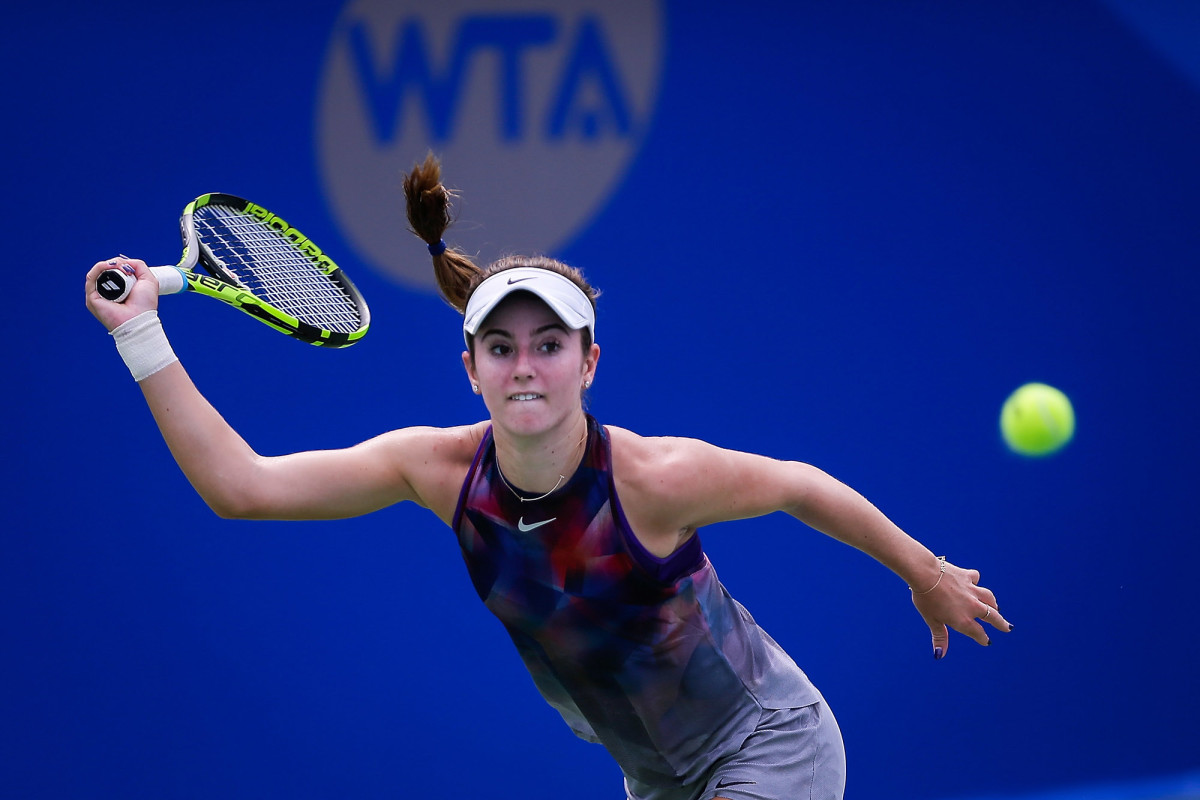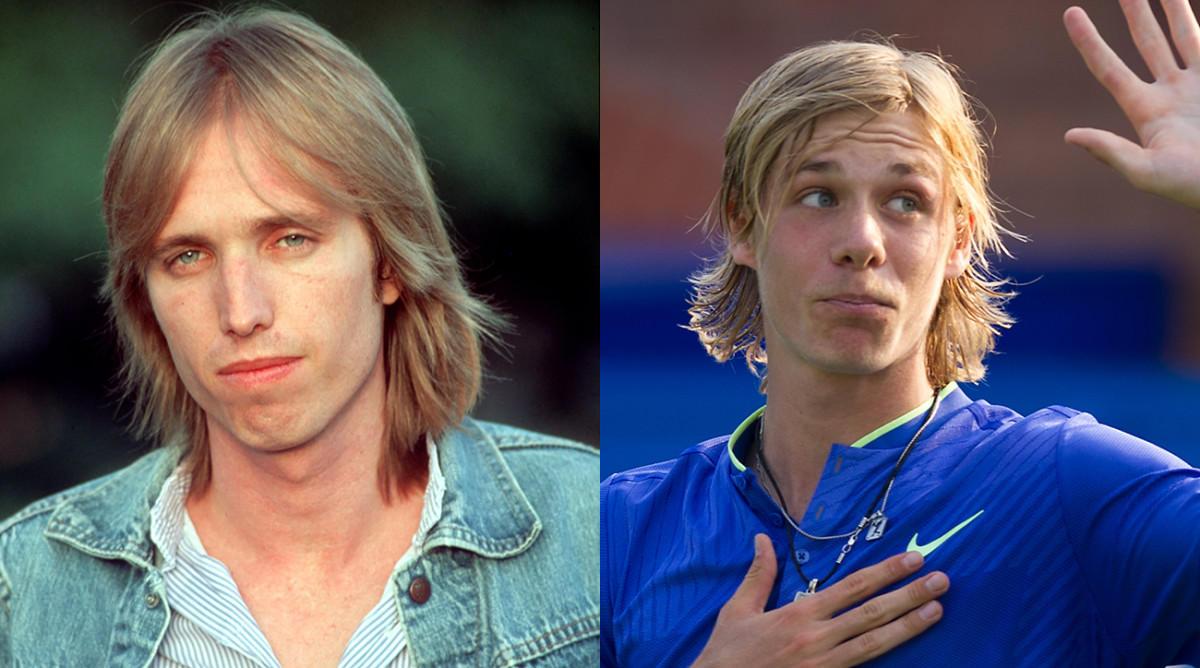Mailbag: The Ups and Downs of Nick Kyrgios Continue

Some housekeeping:
1) Last week’s podcast: The great Courtney Nguyen, WTA doyenne, discussed the state of tennis is Asia.
2) Bonus podcast: here’s one we did in in 2015 with Richard Thaler…who won the Nobel Prize for Economics earlier this week.
3. From the full disclosure department, the WTA sent out its media ballots for 2017. I always think there’s something unseemly and unnecessarily secretive about making these votes in anonymity. Media, ostensibly, exist to serve an audience. Why wouldn’t you inform people about your voting? Here were the options. Under each I include my choice and a brief explanation.
Player of the Year
Simona Halep (ROU)
Garbiñe Muguruza (ESP)
Jelena Ostapenko (LAT)
Karolina Pliskova (CZE)
Elina Svitolina (UKR)
Venus Williams (USA)
• Rankings, be damned, you have to win a Slam to be considered Player of the Year. A little more consistency would have been nice, but we’ll take Muguruza on the basis of Wimbledon and then Cincinnati.
Doubles Team of the Year
Yung-Jan Chan/Martina Hingis (TPE/SUI)
Ekaterina Makarova/Elena Vesnina (RUS/RUS)
Bethanie Mattek-Sands/Lucie Safarova (USA/CZE)
• Our vote went to Yung-Jan Chan/Martina Hingis. Mattek-Sands and Safarova won two majors but for the same reason we cannot vote for Serena, it’s hard to crown a team that didn't complete in two of the majors on account, of course, of BMS’ injury.
Most Improved Player of the Year
Player who is ranked inside the Top 100 and showed significant improvement throughout the 2017 season
Caroline Garcia (FRA)
Kristina Mladenovic (FRA)
Jelena Ostapenko (LAT)
Elina Svitolina (UKR)
CoCo Vandeweghe (USA)
• Ostapenko. In part because a number of the other players—Svitolina most obviously—were already quite accomplished.
Newcomer of the Year
Player who made Top 100 debut or notable accomplishments during the 2017 season
Catherine Bellis (USA)
Beatriz Haddad Maia (BRA)
Elise Mertens (BEL)
Marketa Vondrousova (CZE)
• CiCi Bellis. In part this is personal penance for chirping that she should have gone to Stanford for a year or two.

Comeback Player of the Year
Player whose ranking previously dropped due to injury or personal reasons and current season's results helped restore ranking
Ashleigh Barty (AUS)
Madison Keys (USA)
Petra Kvitova (CZE)
Sloane Stephens (USA)
• In terms of a harrowing-to-heartening story, you have go with Kvitova. In terms of off-the-grid-to-back-in-the-mix, I like Barty. But Sloane Stephens winning no matches until August and then winning the U.S. Open makes this an easier choice.
Mailbag
Have a question or comment for Jon? Email him at jon_wertheim@yahoo.com or tweet him @jon_wertheim.
What is up with this? How long can the tour excuse the inexcusable? Respect the game or be gone...
—Dominic C.
• Life in Kyrgios-ville had been uncharacteristically quiet lately. Then many of us on the East Coast awoke Tuesday to the news that, after dropping a tiebreaker against Stevie Johnson, Kyrgios packed his bags—literally—and quit. The real tragedy here: Kyrgios’ capitulation took attention away from Johnson’s new mustache.
But it also became another exhibit of evidence in the case file against Kyrgios. We spoke just last week about Kyrgios and how we shouldn’t view his career as a binary proposition. Maybe he is immensely talented AND prone to squandering talent. Maybe is poised to win majors AND still at the stage where he does the tennis equivalent of eating ice cream for breakfast.
You know what struck me? We see this a lot from Kyrgios: when he’s not feeling it physically, he checks out. Could be fatigue. Could be an oppressively hot day. Could be his hip or his knee or a stomachache. But when his body betrays him, his will goes, too. This is, potentially, deadly in sports. But especially in a one-on-one sport. If you know that your opponent is prone to tapping out when transported to an uncomfortable place, that’s a considerable mental advantage.
Again, I have a certain amount of admiration and patience for Kyrgios’ “otherness,” for his questioning of authority or convention. He’s proven by now that the “good guy”/“bad guy” taxonomy is an oversimplification. He’s disrespected the sport on multiple occasions; but most of the time he’s the chief victim. On this issue, though, he does a great disservice to his own competitive advantage. I suspect the rest of the field sees results like one in Shanghai and, while the first response is a sheepish “Kyrgios gonna Kyrgios,” the real takeaway is “I know this guy can quit when he’s not feeling his best.”
Here's a weird question: Has Milos Raonic peaked?
—J.B., Portland
• Not so weird. Raonic suddenly turns 27 in a few months and, after a disappointing and injury-plagued 2017, it seems reasonable to take inventory. Let's start with praise. Here’s a guy with limited physical gifts who’s wrung the maximum from his body and game. Here’s a guy who gives himself every opportunity to win, approaching his career as if he were a management consultant, analytically looking for efficiencies and streamlined processes. He’s reached a Wimbledon final, played deep into events on all surfaces and was ranked No. 3 during this unprecedented era.
I suspect part of what’s going on here is the rise of Canadians. Denis Shapovalov and even Felix Auger Aliassime threaten to take some of Raonic’s market share even in his own country. I suspect part of what’s going on here is generational churn. Yoked with Kei Nishikori and Grigor Dimitrov, Raonic has the misfortune of succeeding the Big Four and preceding the younger generation, which is always flush with hype and marketing dollars. Until it’s not. That Raonic is a stable, measured guy—who doesn’t make news with antics and off-court drama and wacky social media posts—might also exaggerate his absence.
Raonic’s big issue was, is and likely always will be, his health. For whatever reasons—and we know this: it’s not sloppy career maintenance—he has trouble staying healthy. At full strength, no way has he peaked. If durability remains such a challenge, then, yes, it’s hard to see him back at No. 3.
Big fan of your intelligent and empathetic writing but I couldn’t disagree more RE the ATP’s decision to disallow an exemption for Dudi Sela to suspend his match in observance of Yom Kippur. Many marquee NBA players in the U.S. are annually “asked” to play on Christmas Day and they do so without complaint to the best of my knowledge. As an individual contractor with the ATP, Mr. Sela should ensure that he doesn’t enter tournament draws that would conflict with his religious obligations. Could it be that he was surprised to find himself in the QFs of Shenzhen instead of losing earlier, thus freeing up his schedule? The ATP shouldn’t be faulted here, as allowing exemptions for global players in an incredibly diverse sport would become a logistical nightmare.
—Steve from Oakland, Calif.
• Yes, we had a lot of questions about Sela last week and—without hearing from all parties—I resisted going all in. I do think that from an optics standpoint alone, the ATP shanked this one. I also don’t think the NBA comparison quite works. Unlike basketball, in tennis there’s a long history of players lobbying—successfully and unsuccessfully—for preferential scheduling. I often link this Harvey Araton piece, remarkable for how openly tournament officials discussed the preferences of players.
As long as this door is open…..
– In the case of Sela, there’s a lot going on here. (That he receives funding from a federation that would not have looked favorably on his playing during Yom Kippur is one factor among many.) As I understand it: a) His Friday match was scheduled second from 2:00 p.m., which would have given four hours to play his match. (Alas the previous match went to three sets.)
– In order accommodate Sela, organizers had already split the quarterfinals 1st / 3rd and 2nd / 4th, ordinarily something to be avoided.
– Had Sela won his quarterfinal, his semifinal was scheduled second, in order to accommodate him.
Bottom line: we can Monday Morning quarterback this (Sukkot Morning quarterback this, as the case may be.) If I’m the ATP, headlines such as “Israel’s top player quits mid-match for Yom Kippur” are regrettable. And perhaps this could have been avoided had Sela simply been first on court on Friday. But all told, considerable efforts were made to accommodate the guy. The whims of tennis simply didn’t cooperate.
Nick Kyrgios Fined $31,085 for Incident at Shanghai Masters
Caroline Wozniacki had enough points to defend so that if she did not she would drop below the YE qualification cutoff before the end date. Venus' point total was guaranteed to remain where she was (or at least to not drop enough points to miss the cutoff). Once Caroline defended enough points, she made the cut.
—Tim D.
• This was re: our question last week about Venus apparently qualifying before Wozniacki when the latter had more points.
Hi Jon, now that Battle of the Sexes has been made, and well received, wouldn't you love to see someone take on A Terrible Splendor, by Marshall Jon Fisher, and all the inherent drama of it? Involving Don Budge, Gottfried Von Cramm and Bill Tilden directly (and of course Adolf Hitler and his cronies as well), but also the other tennis luminaries of the time as well, indirectly. I loved the book and would love seeing a really good film made of it.
I think this is a film that, if made well, would not only be a great addition to the almost non-existent output of tennis films, but a very worthwhile addition to those films studying various aspects of the Western Civilization leading up to World War II.
A wonderful film was made about Jesse Owens very recently. I think a movie of A Terrible Splendor would be great for now, and would also stand the test of time.
—Eric of Jackson Heights
• Love the idea. And couldn't agree more.
We asked Marshall directly and here's his response: A Terrible Splendor has been optioned for movie rights four or five times since it was published in 2009. It is under option again now, and the group that has it is actively developing the project, but it's not at a point where I'm allowed to give details. So who knows what will happen. But I agree that the story and its backdrop would make for a compelling movie. And now we know, from Battle of the Sexes that a high-caliber tennis match can be recreated effectively on screen.
Jon, in light of the sad passing of Tom Petty, I thought it would be interesting comparing his best-known songs to today’s top players based on style of play and character:
“I Won’t Back Down”—Rafa/Serena
“Runnin’ Down a Dream”—Dennis Shapovolov/Sloane Stephens
“Free Fallin’”—Eugenie Bouchard
“American Girl”—U.S. Open semifinalists
“Don’t Do Me Like That”—Almost every one of Roger’s opponents
“Don’t Come Around Here No More”—Ilie Nastase
“Breakdown”—Milos Raonic/Novak Djokovic/Andy Murray
“Yer So Bad”—Nick Kyrgios/Bernard Tomic
Feel free to add!
—Neil Grammer, Toronto
• Damn the Torpedoes. That’s well played. Off the top of my head I’ll add…
“The Waiting”—the players who are fourth on the schedule
“Learnin’ to Fly”—Gael Monfils
“Zombie Zoo”—Ernests Gulbis
Happy to open this up to you guys….
Nadal Wins Sixth Title of Year in Beijing; Garcia Beats Halep
Shots, Miscellany
• Sad it came to this. But great news from Tornado Black:
Update: I'm getting my surgery next Tuesday!!! Thanks to everyone for all the support! It has been beyond amazing! ❤️ pic.twitter.com/SjilGjFfgt
— Tornado Alicia Black (@Tornadoblack98) October 9, 2017
• Joel Druckerreviews Maria Sharapova’s book.
• Brandon writes:If they tried just a little harder they would have caught Isner/Mahut.
• Megan Fernandez of Indy has another LLS: Tom Petty and Denis Shapovalov.

• Finally, you guys were great on the subject of analytics. Violating every principle of statistics—no significance testing!—here’s an interesting example:
I've been thinking a lot about this recently, so it's great timing that you asked about the use of data in tennis.
One thing I really take issue with—and have brought up with [writers], when they write articles based on quantitative analyses of performance—is that tennis seems to miss out on some quant fundamentals. Chief among them, significance testing.
I've seen lots of articles in the past few years that seek to attribute changes in rank, tournaments won, etc. to some factor for which there's a lot of data (sometimes some of the very rich data collected by Tennis Australia).
The stories usually go like this: "Player A moved up from #9 to #4 and made two major finals. It's because of his (almost always a him) increased success on his second serve." What follows is a lot of descriptive statistics—usually % of second serves in, and % of points won on second serves, shown across a few years.
All fine and good, but those are just descriptive statistics. There's no significance testing to demonstrate if those changes are due to randomness or something systematic. It's the bare minimum anyone would need to do to say with confidence (pun intended) that an increase is actually "real."
Beyond that, analysts confuse correlation with causation. You can't say that one thing causes the increase in success. You can certainly say that the increase in %2S points won contributed to matches won, but there may have been other factors. There almost certainly were. Regression analysis would help demonstrate effect size, but nobody does that in tennis.
So what we're left with is broad-stroke generalizing, based on nothing but descriptive statistics. Taking the extra steps wouldn't be difficult, but we don't do it. You'd think it would be useful for fans as well as players and their teams.
Anyhow, I'm glad you brought this topic up. Very timely.
—Andrew Ross, @drewross on Twitter
